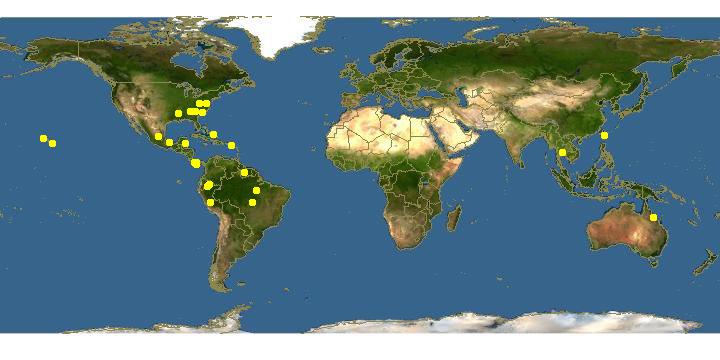
Click on map for details about points.
|
|
Overview | |
Cultivated on low-nutrient agars such as 0.1L-P or 0.1G-0.05 Yxt in association with Escherichia coli, Escherichia coli B/r, or Klebsiella pneumoniae at 22-24 C. Sorocarps usually solitary, at first erect or semi-erect, then inclined, strongly phototropic. Sorophores with bases not enlarged, robust, variable in length, often reaching several centimeters in unidirectional light, commonly 20-40 Ám below and tapering to half that diam. within the sorus, usually sinuous, sometimes tangled in richer cultures, colorless or pigmented in light purple shades. Sori dark vinaceous purple to almost black when mature, globose to citriform, commonly 200-350 Ám in diam. but ranging from 125 to 450 Ám and occasionally more. Spores narrowly elliptical or capsule-shaped, mostly 5.0-7.2 x 2.5-3.2 Ám but ranging up to 8 1Ám or more in length, variable in different strains and within the same isolate, sometimes showing evidence of limited polar granulation. Cell aggregations commonly large, up to 1 cm or more in diam., may develop first as broad sheets of inflowing cells, then as well-defined converging streams, the latter often becoming severed as they advance, each segment forming a separate sorogen; centers of aggregation arise either as fixed focal points or emerge from the rims of vortex-like sites of cell aggregation; sorogens develop from primary centers or from rounded segments of severed streams, erect and columnar. Myxamoebae much as in other dictyostelideae, about 12-18 x 10-15Ám when feeding on an agar surface, becoming more elongate to 20 Ám or more when moving rapidly. Macrocysts produced in some strains and can be homothallic or heterothallic; microcysts not observed or reported.
|
|
|
Links to other sites | |
|
|
|
Acknowledgements | |
The Eumycetozoan Project -- working to understand the ecology, sytematics and evolution of myxomycetes, dictostelids and protostelids -- the true slime molds.
Sponsored by grants from the National Science Foundation.
|
|
|
Feedback |
Please send any corrections and comments about this page to John Shadwick
Department of Biological Sciences, University of Arkansas, Fayetteville, AR 72701, USA
email: jshadwi@uark.edu
phone: USA-479-575-7393.
|
|
| Supported by | |
Updated: 2024-05-06 10:10:48 gmt
|